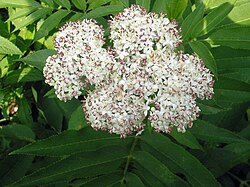| European dwarf elder | |
|---|---|
 | |
| Danewort inflorescence | |
| Scientific classification | |
| Kingdom: | Plantae |
| Clade: | Tracheophytes |
| Clade: | Angiosperms |
| Clade: | Eudicots |
| Clade: | Asterids |
| Order: | Dipsacales |
| Family: | Adoxaceae |
| Genus: | Sambucus |
| Species: | S. ebulus |
| Binomial name | |
| Sambucus ebulus | |
| Synonyms [2] | |
| |

Sambucus ebulus, also known as danewort, dane weed, danesblood, dwarf elder or European dwarf elder, walewort, [3] dwarf elderberry, [4] elderwort and blood hilder, is a herbaceous species of elder, native to southern and central Europe and southwest Asia. The species is a well-established archaeophyte in much of the UK, [5] and is also reportedly naturalized in parts of North America (New York, New Jersey and Québec). [6]
